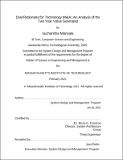| dc.contributor.author | Manyala, Sucharitha. | en_US |
| dc.contributor.other | Massachusetts Institute of Technology. Engineering and Management Program. | en_US |
| dc.contributor.other | System Design and Management Program. | en_US |
| dc.date.accessioned | 2021-10-08T17:10:43Z | |
| dc.date.available | 2021-10-08T17:10:43Z | |
| dc.date.copyright | 2021 | en_US |
| dc.date.issued | 2021 | en_US |
| dc.identifier.uri | https://hdl.handle.net/1721.1/132892 | |
| dc.description | Thesis: S.M. in Engineering and Management, Massachusetts Institute of Technology, System Design and Management Program, February, 2021 | en_US |
| dc.description | Cataloged from the official version of thesis. | en_US |
| dc.description | Includes bibliographical references. | en_US |
| dc.description.abstract | The technology sector is driven by rapid innovations, the pace and magnitude of technological changes and complexities, and a reliance on specialized skills and expertise. Not all firms are able to organically develop all the technologies and capabilities they need to stay competitive. Mergers and acquisitions (M&A) give buyers looking to achieve strategic goals an alternative to organic growth. Technology companies have often pursued M&A as a means to acquire new technology, as an alternative to organic technology development. Strategic motives such as broadening scope, achieving cost synergies, getting access to skills or technologies faster, and several others drive companies to engage in M&A. These motives are widely reported in the literature and are deemed to be critical in improving an organization's financial performance and increasing shareholder value. This thesis summarizes a subset of these motives or deal rationales that are most prominent in the technology sector, analyzes a sample of past technology deals between 2008 and 2018, and categorizes them based on the strategic intent behind the deal-making. This study examines the long-term value these motives generate in each category by measuring and comparing financial metrics pre- and post-merger. Various financial metrics like quick-ratio, CAGR (compound annual growth rate) and total shareholder return (TSR) are analyzed in the process and ultimately TSR has been chosen to measure the long-term value of the deals in this study. This study concludes "Cross-Selling" and "Acquiring technical capabilities" as having probability of higher returns and higher success rate among those studied. | en_US |
| dc.description.statementofresponsibility | by Sucharitha Manyala. | en_US |
| dc.format.extent | 102 pages | en_US |
| dc.language.iso | eng | en_US |
| dc.publisher | Massachusetts Institute of Technology | en_US |
| dc.rights | MIT theses may be protected by copyright. Please reuse MIT thesis content according to the MIT Libraries Permissions Policy, which is available through the URL provided. | en_US |
| dc.rights.uri | http://dspace.mit.edu/handle/1721.1/7582 | en_US |
| dc.subject | Engineering and Management Program. | en_US |
| dc.subject | System Design and Management Program. | en_US |
| dc.title | Deal rationales for technology M&A : an analysis of the two year value generated | en_US |
| dc.title.alternative | Deal rationales for technology mergers and acquisitions | en_US |
| dc.type | Thesis | en_US |
| dc.description.degree | S.M. in Engineering and Management | en_US |
| dc.contributor.department | Massachusetts Institute of Technology. Engineering and Management Program | en_US |
| dc.identifier.oclc | 1263357763 | en_US |
| dc.description.collection | S.M.inEngineeringandManagement Massachusetts Institute of Technology, System Design and Management Program | en_US |
| dspace.imported | 2021-10-08T17:10:43Z | en_US |
| mit.thesis.degree | Master | en_US |
| mit.thesis.department | SysDes | en_US |
